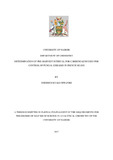| dc.description.abstract | French beans export contribution to the economy of Kenya has seen it become the second foreign exchange earner after tea; providing employment, increased food security and sustainable development in the country. In the process of crop production, farmers use pesticides to control pest and diseases to improve the yield and quality of the produce. Pre-Harvest Interval (PHI) is observed to reduce the risk of human exposure to pesticide carry over through food. In this study the PHI of carbendazim in French beans was evaluated in a supervised field trial conducted in Kambaa and Naivasha regions in Kenya. The data collected through a questionnaire showed that exporters of French beans deal with more than one variety and were aware of fungal diseases affecting French beans. To control the pest, exporters uses pesticide such as carbendazim. The field trial was conducted in the months of September to November, 2015 and March to May, 2016. Pesticide under the study was applied at the rate of 625g of carbendazim per hectare before harvest and samples collected at 0, 3, 7, 14 and 16 days after application. Laboratory samples were analysed for presence of carbendazim residues using Liquid Chromatography Quadruple (Agilent 6430 LCMSMS) with standard Electron Spray Ionization (ESI).The study revealed that in the short and long rain seasons, the breakdown of carbendazim in French beans followed a similar pattern of residue degradation irrespective of the formulations, season or location. Degradation in the first three days after the pesticide application was sharp ranging from 36.4% and 60.6%. The results showed that the pesticide residue degraded to below the European Union (EU) set maximum residue limit (MRL) of 200μg/kg at 7 days after application. Degradation of carbendazim in French beans follows Langmuir-Hinshelwood kinetic equation and a dissipation half-life of carbendazim in French beans was found to be 1.7 days. A PHI of 5 days was found to be sufficient for carbendazim if applied in the recommended rate of 625g per hectare with all Good Agricultural Practice (GAP) observed. A National Tolerance Level of 74μg/kg was proposed to be used by the relevant government authorities as a buffer level for compliance monitoring. | en_US |



